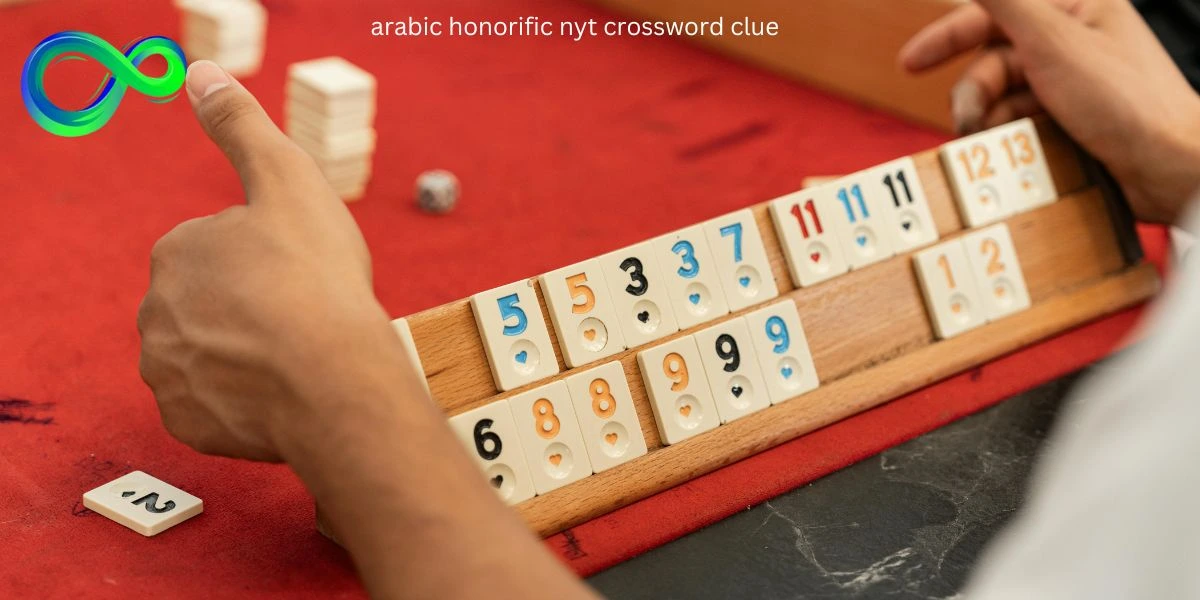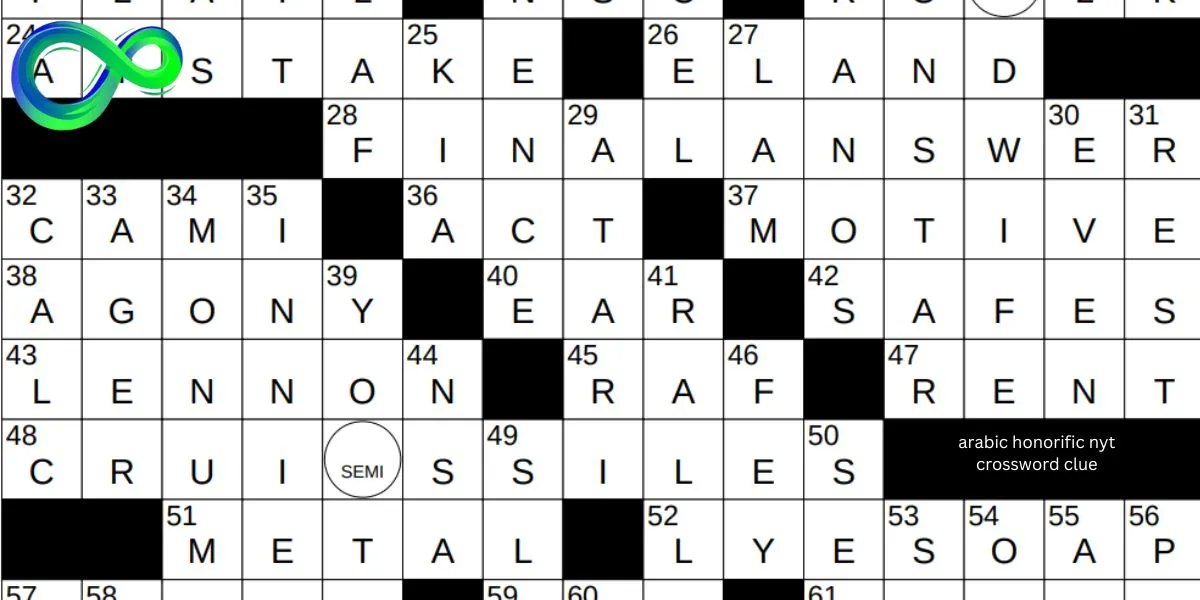Arab Honorific NYT: From Sheikhs to Emirs
In the crossword world, some clues are more visible than others because of their linguistic or cultural relevance. The “Arab title” is one such clue that has piqued the interest of many crossword players, especially those who participate in the New York Times (NYT) crossword.
“Arab Honorific NYT” refers to the use of culturally significant titles in New York Times articles to accurately represent Arab figures and traditions. The vast legacy of titles and honorifics that permeates Arab society can be seen in the Arab title NYT, which is more than just a straightforward clue.
This article offers an in-depth overview of this fascinating crossword problem by exploring the meaning, relevance, and typical solutions related to the Arab honorific NYT.
Also read:
Suffix with Beatle or Wrestle NYT
What is an Arab Honorific NYT?
An Arab honorific is a sign of honor or respect usually employed in Arab culture. Those of high social status, religious authority, or royalty are frequently addressed or mentioned with these honorifics.
Arab honorifics such as “Sheikh,” “Emir,” “Sultan,” and “Sayyid” are frequently used. The usage of each term is ingrained in Arab social customs and has particular cultural and past significance.
The Arab honorific NYT clue is a unique and culturally interesting puzzle element since it frequently asks solvers to identify one of these titles. For example, “Emir” or “Sheik” could be the answer to a crossword puzzle that requests a four-letter Arab honorific.
Your ability to successfully solve these clues can be significantly enhanced by being familiar with their titles and their meanings.
Arab Honorific in NYT Crossword Clues
The Arab honorific NYT clue is just one of many witty and occasionally difficult clues found in the New York Times crossword puzzle. This clue, which can take many different forms, requires solvers to name a particular honorific term that is utilized in Arab culture.
The quantity of letters needed and the accompanying clues that offer further context frequently determine the answer to the Arab honorific NYT clue.
The Arab honor NYT crossword clue, for example, was featured on June 16, 2024, forcing solvers to consider their understanding of Arab titles fully. “Emir,” a common epithet used to indicate a king or leader in some Arab countries, was the answer to this specific mystery.
This clue emphasizes how crucial it is to comprehend cultural quirks when solving crossword puzzles.

Historical and Cultural Significance of Arab Honorifics
Arab honorifics hold deep historical and cultural significance, connecting people with their heritage and social values. These honorifics, such as Sheikh, Emir, and Sayyid, convey respect, lineage, and authority within Arab society.
Each title carries meaning rooted in the Arabic language and reflects the complex social structures and relationships that have evolved over centuries.
1. Roots in Arabic Language
The origins of Arab honorifics trace back to early Arab tribes and the Arabic language itself, where respect and identity were closely tied to one’s title or lineage.
These honorifics became an essential part of daily interactions, distinguishing leaders, elders, and respected individuals within communities.
2. Religious Influence
Islam has significantly influenced the use of honorifics, as religious and cultural practices merged over time.
Honorifics such as Sayyid, meaning a descendant of the Prophet Muhammad (S.A.W), hold special religious reverence, underscoring the respect for noble ancestry within Islam.
3. Social Hierarchy and Respect
In Arab culture, honorifics are a means of expressing social hierarchy and respect. Titles convey a person’s standing within society, creating a respectful, structured framework for interactions.
The continued use of these honorifics illustrates how cultural values of respect, lineage, and authority are preserved across generations.
The NYT’s Approach to Arab Honorifics
1. Historical Coverage
The New York Times (NYT) has a long history of reporting on Arab leaders, scholars, and public figures, often including traditional Arab honorifics to show respect and recognition. These titles, like “Sheikh,” “Emir,” or “Sayyid,” are significant in Arab culture, reflecting a person’s social status, religious importance, or noble lineage.
Over the years, the NYT has adapted its approach to include these honorifics thoughtfully, striving to reflect the cultural importance they carry.
2. Examples of Coverage
In cases covering prominent figures such as Sheikh Mohammed bin Rashid Al Maktoum or Sayyid Ali al-Husseini al-Sistani, the NYT has often employed honorifics to convey respect and context for readers.
Such titles provide readers with cultural cues that enrich the narrative, helping to bridge cultural understanding for an international audience.
3. Accuracy and Sensitivity
The NYT aims to use Arab honorifics with accuracy, reflecting both the position of the individual and the cultural context. Their editorial practices emphasize respect and strive to avoid misinterpretation, underscoring the paper’s commitment to cultural sensitivity.
By using honorifics correctly, the NYT builds trust with readers and respects Arab cultural traditions in its reporting.
Case Studies in Arab Honorific Representation
1. Prominent Figures
Arab honorifics are often used for respected figures like Sheikh Mohammed bin Rashid Al Maktoum and Sayyid Ali al-Husseini al-Sistani. These titles, such as Sheikh or Sayyid, signify leadership, noble lineage, or religious authority.
Their use in media helps convey the cultural and social status these individuals hold in Arab societies.
2. How NYT Addresses These Figures
The New York Times (NYT) incorporates Arab honorifics in articles to show respect and accuracy.
When mentioning prominent Arab leaders, the NYT usually retains their titles to reflect proper social standing, carefully balancing readability for a global audience with cultural authenticity.
3. Public Perception
Readers’ reactions vary. Many appreciate the NYT’s cultural sensitivity, seeing it as a sign of respect.
However, some readers may be unfamiliar with these honorifics and misinterpret them, highlighting the importance of media outlets in educating audiences about cultural nuances while respecting traditions.
Why Understanding Arab Honorifics NYT Matters?
Tackling crosswords like the Arab honorific NYT along with comprehending the cultural importance of these titles require an understanding of Arab honorifics.
Honorifics are more than just official titles in Arab culture; they stand for authority, respect, and a strong bond with customs and history.
You can learn more about the values and social systems of Arab societies by being familiar with these titles.

Tips for Solving the Arab Honorific NYT Clue
These are some ideas to help you reply to the Arab formal NYT clue if you come across it in a cryptic puzzle:
1. Consider the Length of the Answer: The primary hint is how many of letters needed to finish the answer. Depending on the needs of the challenge, common Arab honorifics like “Emir” (four letters) or “Sheik” (five letters) might work.
2. Think About Context: Context data gathered from nearby cues can assist focus the list of potential responses. For example, “Emir” would be probably the answer if the theme of this issue is royalty or power.
3. Familiarize Yourself with Common Titles: Knowing the most common Arab titles is going to help you. It’s also important to be aware of titles like “Sultan” and “Sayyid.”
4. Arab Honorific NYT and Cultural Awareness: A sign of the rising respect and awareness for other cultures in popular media is the inclusion of the Arab honorific NYT clue in crossword puzzles.
The Arab honorific NYT clue shows how crossword puzzles use cultural information, often reflecting the society that develops them.
By figuring out these hints, you challenge your ability to solve puzzles and interact with many cultural aspects, which expands your perspective on the world.
Additional Insights into the Arab Honorific NYT
1. Historical Context of Arab Honorifics NYT
The Arab honorific NYT puzzle frequently references this rich history, making it difficult for solvers to connect historical significance with modern usage.
2. The Role of Religion in Arab Honorifics NYT
In Arab culture, the use of titles is greatly influenced by religion. Titles like “Sayyid” particularly denote a highly esteemed family, as they often reserve them for the Prophet Muhammad’s descendants.
In addition to showing respect, using such titles acknowledges one’s religious ancestry. Determining the religious meanings of these titles can offer important clues to unlock the enigma of the Arab honorific NYT.
For instance, when the clue calls for a spiritually significant honorific, “Sayyid” might be the right response.
3. Modern Adaptations of Arab Honorifics NYT
Common Misconceptions About Arab Honorifics NYT
Arab titles may be thought to be solely tribal or spiritual titles. Many honorifics have tribal or religious roots, while others widely denote authority or respect in various social and professional contexts.
People use the honorific “Hajji” to honor someone who has completed the Hajji trip to Mecca. It can also be used more widely to honor an elder.
Conclusion: Arab Honorific NYT
With the understanding of titles like “Emir” and “Sheikh,” which have important cultural connotations in Arab society, you will be ready to handle the Arab honorific NYT hint with confidence the next time you encounter it.
FAQs: Arab Honorific NYT
Here are some FAQs about Arab Honorific NYT. We try to explain everything further if you have any questions to related this topic our team expert is available 24/7.
1. What Are Some Examples of Arab Honorifics?
Examples of Arab honorifics include Sheikh (a respected elder or leader), Emir (ruler or prince), and Sayyid (a person of noble lineage), each reflecting cultural respect.











